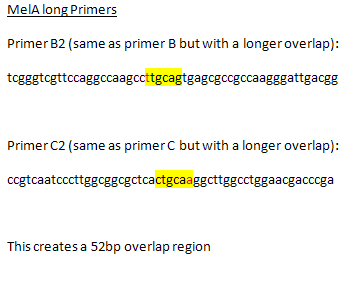Team:Cambridge/Notebook/Week8
From 2009.igem.org
(→Wednesday) |
(→Thursday) |
||
| Line 56: | Line 56: | ||
== Thursday == | == Thursday == | ||
| + | |||
| + | ===Wet Work=== | ||
| + | |||
| + | ====Melanin Biobrick==== | ||
| + | |||
| + | Talked with Jim Ajioka about the gel smears after the Melanin PCR. he suggested re-ordering Primers B and C with a longer overlap region, which would make the fragments easier to stick together. In view of this, new primers were designed (shown below): | ||
| + | |||
| + | [[Image:Longer_primers.PNG]] | ||
{{Template:CambridgeNewPage}} | {{Template:CambridgeNewPage}} | ||
Revision as of 09:26, 4 September 2009
Categories :
Project :
-
Overview
Sensitivity Tuner
--- Characterisation
--- Modelling
Colour Generators
--- Carotenoids (Orange/Red)
--- Melanin (Brown)
--- Violacein (Purple/Green)
The Future
Safety
Notebook :
Team Logistics :
Week 8
Monday
Wet Work
Threshold device
Transformed 72, 92, 94, and 95 in pSB3K3 into arabinose strain.
Melanin Biobrick
Did the last stage of PCR for the Melanin Biobrick creation. Fragments AB and CF were added with primers A and F and the Finnzymes enzyme, then run on a CYBR-safe gel. The results showed smears rather than bands. As the CF fragment was a little dodgy on the first extraction it was decided to re-extract and try again.
The CF band was reproduced and extracted in the afternoon, creating more CF fragment stock.
Dry Work
Tuesday
Wet Work
Threshold device
Successfully moved 70, 71, 72, 74, 91 into pSB3K3. That makes all 15 activator constructs yay!
Melanin Biobrick
Re-tried the PRC using the new CF fragment under the same PCR conditions. Still getting smeared bands.
Dry Work
Wednesday
Wet Work
Melanin Biobrick
Looked up the possible reasons for smeared bands after PCR, three main ones discovered:
- Too much template DNA
- Incorrect salt concentration
- Comtaminated PCR mix
Nanodropped the fragments and diluted AB 1/10 to get the recommended DNA concentration, and used new pipettes and Primer aliquots. Two tubes were made up using a new Finnzymes mix, and two using the old one.
The gel still showed smears! For all the samples.
Thursday
Wet Work
Melanin Biobrick
Talked with Jim Ajioka about the gel smears after the Melanin PCR. he suggested re-ordering Primers B and C with a longer overlap region, which would make the fragments easier to stick together. In view of this, new primers were designed (shown below):
 "
"
